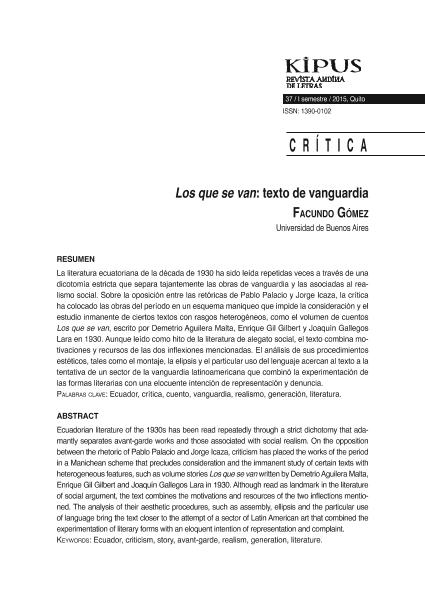Mostrar el registro sencillo del ítem
dc.contributor.author
Gomez, Facundo Enrique

dc.date.available
2019-03-21T20:06:20Z
dc.date.issued
2015-12
dc.identifier.citation
Gomez, Facundo Enrique; Los que se van: texto de vanguardia; Universidad Andina Simón Bolívar; Kipus; 37; 12-2015; 89-112
dc.identifier.issn
1390-0102
dc.identifier.uri
http://hdl.handle.net/11336/72228
dc.description.abstract
La literatura ecuatoriana de la década de 1930 ha sido leída repetidas veces a través de una dicotomía estricta que separa tajantemente las obras de vanguardia y las asociadas al realismo social. Sobre la oposición entre las retóricas de Pablo Palacio y Jorge Icaza, la crítica ha colocado las obras del período en un esquema maniqueo que impide la consideración y el estudio inmanente de ciertos textos con rasgos heterogéneos, como el volumen de cuentos Los que se van, escrito por Demetrio Aguilera Malta, Enrique Gil Gilbert y Joaquín GallegosLara en 1930. Aunque leído como hito de la literatura de alegato social, el texto combina motivaciones y recursos de las dos inflexiones mencionadas. El análisis de sus procedimientos estéticos, tales como el montaje, la elipsis y el particular uso del lenguaje acercan al texto a la tentativa de un sector de la vanguardia latinoamericana que combinó la experimentación de las formas literarias con una elocuente intención de representación y denuncia.
dc.description.abstract
Ecuadorian literature of the 1930s has been read repeatedly through a strict dichotomy that adamantly separates avant-garde works and those associated with social realism. On the opposition between the rhetoric of Pablo Palacio and Jorge Icaza, criticism has placed the works of the period in a Manichean scheme that precludes consideration and the immanent study of certain texts with heterogeneous features, such as volume stories Los que se van written by Demetrio Aguilera Malta, Enrique Gil Gilbert and Joaquín Gallegos Lara in 1930. Although read as landmark in the literature of social argument, the text combines the motivations and resources of the two inflections mentioned. The analysis of their aesthetic procedures, such as assembly, ellipsis and the particular use of language bring the text closer to the attempt of a sector of Latin American art that combined the experimentation of literary forms with an eloquent intention of representation and complaint.
dc.format
application/pdf
dc.language.iso
spa
dc.publisher
Universidad Andina Simón Bolívar
dc.rights
info:eu-repo/semantics/openAccess
dc.rights.uri
https://creativecommons.org/licenses/by-nc-sa/2.5/ar/
dc.subject
Literatura Ecuatoriana
dc.subject
Vanguardia
dc.subject
Realismo
dc.subject.classification
Estudios Generales del Lenguaje

dc.subject.classification
Lengua y Literatura

dc.subject.classification
HUMANIDADES

dc.title
Los que se van: texto de vanguardia
dc.type
info:eu-repo/semantics/article
dc.type
info:ar-repo/semantics/artículo
dc.type
info:eu-repo/semantics/publishedVersion
dc.date.updated
2019-03-11T14:11:41Z
dc.journal.number
37
dc.journal.pagination
89-112
dc.journal.pais
Ecuador

dc.journal.ciudad
Quito
dc.description.fil
Fil: Gomez, Facundo Enrique. Consejo Nacional de Investigaciones Científicas y Técnicas; Argentina. Universidad de Buenos Aires. Facultad de Filosofía y Letras. Instituto Interdisciplinario de Estudios e Investigación de América Latina; Argentina
dc.journal.title
Kipus
dc.relation.alternativeid
info:eu-repo/semantics/altIdentifier/url/http://hdl.handle.net/10644/5254
Archivos asociados
